Deck 11: Externalities, Property Rights, and the Environment
Question
Question
Question
Question
Question
Question
Question
Question
Question
Question
Question
Question
Question
Question
Question
Question
Question
Question
Question
Question
Question
Question
Question
Question
Question
Question
Question
Question
Question
Question
Question
Question
Question
Question
Question
Question
Question
Question
Question
Question
Question
Question
Question
Question
Question
Question
Question
Question
Question
Question
Question
Question
Question
Question
Question
Question
Question
Question
Question
Question
Question
Question
Question
Question
Question
Question
Question
Question
Question
Question
Question
Question
Question
Question
Question
Question
Question
Question
Question
Question

Unlock Deck
Sign up to unlock the cards in this deck!
Unlock Deck
Unlock Deck
1/184
Play
Full screen (f)
Deck 11: Externalities, Property Rights, and the Environment
1
If the production of a good generates a positive externality, then:
A)production of the good is harmful.
B)there will be deadweight loss at the market equilibrium quantity.
C)total economic surplus will be maximized at the market equilibrium quantity.
D)the government should tax producers of the good.
A)production of the good is harmful.
B)there will be deadweight loss at the market equilibrium quantity.
C)total economic surplus will be maximized at the market equilibrium quantity.
D)the government should tax producers of the good.
there will be deadweight loss at the market equilibrium quantity.
2
The existence of a negative externality will result in:
A)a less than optimal level of production.
B)a greater than optimal level of production.
C)prices that are artificially high.
D)elimination of deadweight loss.
A)a less than optimal level of production.
B)a greater than optimal level of production.
C)prices that are artificially high.
D)elimination of deadweight loss.
a greater than optimal level of production.
3
Which of the following is NOT an example of an activity with external benefits?
A)Eating a sandwich in the dining hall
B)Planting flowers in your front yard
C)Installing smoke alarms in your house
D)Having your car's faulty exhaust system repaired
A)Eating a sandwich in the dining hall
B)Planting flowers in your front yard
C)Installing smoke alarms in your house
D)Having your car's faulty exhaust system repaired
Eating a sandwich in the dining hall
4
If either the production or consumption of a good generates an external benefit, then the:
A)social demand curve will lie to the right of the private demand curve.
B)social demand curve will lie to the left of the private demand curve.
C)social marginal cost curve will lie to the left of the private marginal cost curve.
D)social marginal cost of the good will equal zero.
A)social demand curve will lie to the right of the private demand curve.
B)social demand curve will lie to the left of the private demand curve.
C)social marginal cost curve will lie to the left of the private marginal cost curve.
D)social marginal cost of the good will equal zero.

Unlock Deck
Unlock for access to all 184 flashcards in this deck.
Unlock Deck
k this deck
5
On Saturdays, Stan goes to the park to play his saxophone. Some of the people in the park love listening to Stan play, while others find his music really annoying. In this case, Stan's saxophone playing generates:
A)a negative externality.
B)a positive externality.
C)neither a positive nor a negative externality.
D)both positive and negative externalities.
A)a negative externality.
B)a positive externality.
C)neither a positive nor a negative externality.
D)both positive and negative externalities.

Unlock Deck
Unlock for access to all 184 flashcards in this deck.
Unlock Deck
k this deck
6
Suppose Frank likes to snack on sugary candy. Frank knows that it's bad for his teeth to eat sugary candy, but he doesn't care. Frank's snacking habits have no impact on anyone other than Frank. In this case, Frank's consumption of sugary candy generates:
A)a negative externality.
B)a positive externality.
C)neither a positive nor a negative externality.
D)both a positive and a negative externality.
A)a negative externality.
B)a positive externality.
C)neither a positive nor a negative externality.
D)both a positive and a negative externality.

Unlock Deck
Unlock for access to all 184 flashcards in this deck.
Unlock Deck
k this deck
7
If the market equilibrium quantity is greater than the socially optimal quantity, one can infer that:
A)the private supply curve for the activity is to the left of the socially optimal supply curve.
B)the private demand curve for the activity is below the socially optimal demand.
C)there is a positive externality associated with this good.
D)there is a negative externality associated with this good.
A)the private supply curve for the activity is to the left of the socially optimal supply curve.
B)the private demand curve for the activity is below the socially optimal demand.
C)there is a positive externality associated with this good.
D)there is a negative externality associated with this good.

Unlock Deck
Unlock for access to all 184 flashcards in this deck.
Unlock Deck
k this deck
8
If coal mining produces a negative externality because it leads to environmental damage, then, at the market equilibrium, the:
A)price of coal will be higher than the socially optimal price.
B)quantity of coal produced will be less than the socially optimal quantity.
C)quantity of coal produced will be greater than the socially optimal quantity.
D)supply curve will lie to the left of the regulated supply curve.
A)price of coal will be higher than the socially optimal price.
B)quantity of coal produced will be less than the socially optimal quantity.
C)quantity of coal produced will be greater than the socially optimal quantity.
D)supply curve will lie to the left of the regulated supply curve.

Unlock Deck
Unlock for access to all 184 flashcards in this deck.
Unlock Deck
k this deck
9
If the equilibrium quantity is equal to the socially optimal quantity, one can infer that:
A)the supply curve for the activity is below the socially optimal supply curve.
B)there is no externality associated with this good.
C)there is a positive externality associated with this good.
D)there is a negative externality associated with this good.
A)the supply curve for the activity is below the socially optimal supply curve.
B)there is no externality associated with this good.
C)there is a positive externality associated with this good.
D)there is a negative externality associated with this good.

Unlock Deck
Unlock for access to all 184 flashcards in this deck.
Unlock Deck
k this deck
10
If either the production or consumption of a good generates an external cost, then the:
A)social demand curve will lie to the right of the private demand curve.
B)social marginal cost curve will lie to the right of the private marginal cost curve.
C)social marginal cost curve will lie to the left of the private marginal cost curve.
D)social demand for the good will equal zero.
A)social demand curve will lie to the right of the private demand curve.
B)social marginal cost curve will lie to the right of the private marginal cost curve.
C)social marginal cost curve will lie to the left of the private marginal cost curve.
D)social demand for the good will equal zero.

Unlock Deck
Unlock for access to all 184 flashcards in this deck.
Unlock Deck
k this deck
11
Which of the following is an example of an activity with an external cost?
A)Raising honeybees where neighbors on all sides grow apples.
B)Keeping your front yard clean.
C)Speeding on the interstate.
D)Having to buy batteries for the new remote that came with a TV.
A)Raising honeybees where neighbors on all sides grow apples.
B)Keeping your front yard clean.
C)Speeding on the interstate.
D)Having to buy batteries for the new remote that came with a TV.

Unlock Deck
Unlock for access to all 184 flashcards in this deck.
Unlock Deck
k this deck
12
If the market equilibrium quantity is less than the socially optimal quantity, one can infer that:
A)the private supply curve for the activity is below the socially optimal supply curve.
B)the private demand curve for the activity is above the socially optimal demand.
C)there is a positive externality associated with this good.
D)there is a negative externality associated with this good.
A)the private supply curve for the activity is below the socially optimal supply curve.
B)the private demand curve for the activity is above the socially optimal demand.
C)there is a positive externality associated with this good.
D)there is a negative externality associated with this good.

Unlock Deck
Unlock for access to all 184 flashcards in this deck.
Unlock Deck
k this deck
13
If the production of oranges generates an external benefit, then we would expect the market equilibrium quantity of oranges to be:
A)equal to the socially optimal quantity.
B)less than the socially optimal quantity.
C)greater than the socially optimal quantity.
D)equal to the socially optimal quantity plus the external benefit.
A)equal to the socially optimal quantity.
B)less than the socially optimal quantity.
C)greater than the socially optimal quantity.
D)equal to the socially optimal quantity plus the external benefit.

Unlock Deck
Unlock for access to all 184 flashcards in this deck.
Unlock Deck
k this deck
14
Given that most people like the smell of baking cinnamon rolls and dislike the smell of burning tires, baking cinnamon rolls generates ________ externality, and burning tires generates ________ externality.
A)a positive; a negative
B)a negative; a positive
C)a positive, no
D)no; a negative
A)a positive; a negative
B)a negative; a positive
C)a positive, no
D)no; a negative

Unlock Deck
Unlock for access to all 184 flashcards in this deck.
Unlock Deck
k this deck
15
If the consumption of good generates an external benefit, then the market equilibrium quantity will be:
A)socially optimal.
B)less than the socially optimal quantity.
C)greater than the socially optimal quantity.
D)equal to zero.
A)socially optimal.
B)less than the socially optimal quantity.
C)greater than the socially optimal quantity.
D)equal to zero.

Unlock Deck
Unlock for access to all 184 flashcards in this deck.
Unlock Deck
k this deck
16
A benefit of an activity received by people not participating in the activity is called a(n):
A)winner's curse.
B)positive externality.
C)external cost.
D)negative externality.
A)winner's curse.
B)positive externality.
C)external cost.
D)negative externality.

Unlock Deck
Unlock for access to all 184 flashcards in this deck.
Unlock Deck
k this deck
17
A cost of an activity that falls on people not engaged in the activity is called a(n):
A)external benefit.
B)prisoner's dilemma.
C)negative externality.
D)positive externality.
A)external benefit.
B)prisoner's dilemma.
C)negative externality.
D)positive externality.

Unlock Deck
Unlock for access to all 184 flashcards in this deck.
Unlock Deck
k this deck
18
Carmen listens to opera music every evening when she gets home from work. Carmen loves listening to opera, but her neighbor Paul, who can also hear the music, hates it. If Paul is the only person besides Carmen who can hear the music, then Carmen's music generates:
A)a negative externality.
B)a positive externality.
C)neither a positive nor a negative externality.
D)both a positive and a negative externality.
A)a negative externality.
B)a positive externality.
C)neither a positive nor a negative externality.
D)both a positive and a negative externality.

Unlock Deck
Unlock for access to all 184 flashcards in this deck.
Unlock Deck
k this deck
19
In the case of either a positive or negative externality, a good's market price will:
A)be too low.
B)be too high.
C)not fully reflect a good's social marginal cost or social marginal benefit.
D)not equate the quantity supplied by sellers with the quantity demanded by buyers.
A)be too low.
B)be too high.
C)not fully reflect a good's social marginal cost or social marginal benefit.
D)not equate the quantity supplied by sellers with the quantity demanded by buyers.

Unlock Deck
Unlock for access to all 184 flashcards in this deck.
Unlock Deck
k this deck
20
If either the production or consumption of a good generates an external cost, then the market equilibrium quantity will be:
A)socially optimal.
B)less than the socially optimal quantity.
C)greater than the socially optimal quantity.
D)equal to zero.
A)socially optimal.
B)less than the socially optimal quantity.
C)greater than the socially optimal quantity.
D)equal to zero.

Unlock Deck
Unlock for access to all 184 flashcards in this deck.
Unlock Deck
k this deck
21
The Coase theorem states that if private parties can negotiate the purchase and sale of the right to perform activities that cause externalities, then they:
A)can always arrive at efficient solutions to the problems caused by externalities.
B)will never arrive at efficient solutions to the problems caused by externalities.
C)will never perform activities that generate negative externalities.
D)will always perform activities that generate positive externalities.
A)can always arrive at efficient solutions to the problems caused by externalities.
B)will never arrive at efficient solutions to the problems caused by externalities.
C)will never perform activities that generate negative externalities.
D)will always perform activities that generate positive externalities.

Unlock Deck
Unlock for access to all 184 flashcards in this deck.
Unlock Deck
k this deck
22
Refer to the figure below. The deadweight loss at the market equilibrium quantity is equal to the area ________. 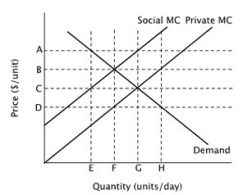
A)½ × EF × AC
B)½ × FG × BD
C)½ × FG × AC
D)½ × GH × BD

A)½ × EF × AC
B)½ × FG × BD
C)½ × FG × AC
D)½ × GH × BD

Unlock Deck
Unlock for access to all 184 flashcards in this deck.
Unlock Deck
k this deck
23
If the production of a good generates a negative externality, then at the market equilibrium quantity, the marginal cost to society of another unit of the good will be:
A)less than the marginal benefit of another unit.
B)greater than the marginal benefit of another unit.
C)equal to the marginal benefit of another unit.
D)negative due to the external cost.
A)less than the marginal benefit of another unit.
B)greater than the marginal benefit of another unit.
C)equal to the marginal benefit of another unit.
D)negative due to the external cost.

Unlock Deck
Unlock for access to all 184 flashcards in this deck.
Unlock Deck
k this deck
24
Consider two restaurants located next door to each other: Quick Burger and The Sunshine Café. If Quick Burger opens a drive-through window, the increased traffic and noise will bother customers seated outside at The Sunshine Café. The table below shows the monthly payoffs to Quick Burger and The Sunshine Café when Quick Burger does and does not operate a drive-through window. If Quick Burger has the legal right to operate a drive-through window, then the Sunshine Café would be willing to pay Quick Burger as much as ________ per month to NOT operate a drive-through window.
A)$9,000
B)$11,000
C)$12,000
D)$15,000
A)$9,000
B)$11,000
C)$12,000
D)$15,000

Unlock Deck
Unlock for access to all 184 flashcards in this deck.
Unlock Deck
k this deck
25
Consider two restaurants located next door to each other: Quick Burger and The Sunshine Café. If Quick Burger opens a drive-through window, the increased traffic and noise will bother customers seated outside at The Sunshine Café. The table below shows the monthly payoffs to Quick Burger and The Sunshine Café when Quick Burger does and does not operate a drive-through window.  Is it socially optimal for Quick Burger to operate a drive-through window?
Is it socially optimal for Quick Burger to operate a drive-through window?
A)No, because The Sunshine Café's payoff is lower when Quick Burger operates a drive-through window.
B)No, because total payoffs are higher when Quick Burger does not operate a drive-through window.
C)Yes, because Quick Burger's payoff is higher when Quick Burger operates a drive-though window.
D)Yes, because total payoffs are higher when Quick Burger operates a drive-through window.
 Is it socially optimal for Quick Burger to operate a drive-through window?
Is it socially optimal for Quick Burger to operate a drive-through window?A)No, because The Sunshine Café's payoff is lower when Quick Burger operates a drive-through window.
B)No, because total payoffs are higher when Quick Burger does not operate a drive-through window.
C)Yes, because Quick Burger's payoff is higher when Quick Burger operates a drive-though window.
D)Yes, because total payoffs are higher when Quick Burger operates a drive-through window.

Unlock Deck
Unlock for access to all 184 flashcards in this deck.
Unlock Deck
k this deck
26
Suppose that a vaccine is developed for a highly contagious strain of flu. The likelihood that anyone will get this flu decreases as more people receive the vaccine. One of the demand curves below represents the private demand for the vaccine and the other represents the social demand for the vaccine. 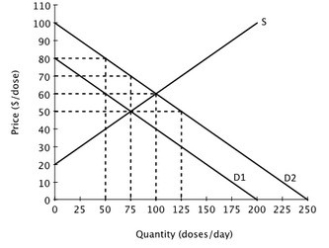 The external benefit of each dose is:
The external benefit of each dose is:
A)$70
B)$50
C)$30
D)$20
 The external benefit of each dose is:
The external benefit of each dose is:A)$70
B)$50
C)$30
D)$20

Unlock Deck
Unlock for access to all 184 flashcards in this deck.
Unlock Deck
k this deck
27
Consider two restaurants located next door to each other: Quick Burger and The Sunshine Café. If Quick Burger opens a drive-through window, the increased traffic and noise will bother customers seated outside at The Sunshine Café. The table below shows the monthly payoffs to Quick Burger and The Sunshine Café when Quick Burger does and does not operate a drive-through window. If Quick Burger has the legal right to operate a drive-through, and Quick Burger and The Sunshine Café can negotiate with each other at no cost, then will Quick Burger operate a drive-through window?
A)No, because it is not socially efficient to operate a drive-through.
B)Yes, because Quick Burger's payoff is higher when it operates a drive-through.
C)No, because it would lower the payoff for The Sunshine Café.
D)It cannot be determined.
A)No, because it is not socially efficient to operate a drive-through.
B)Yes, because Quick Burger's payoff is higher when it operates a drive-through.
C)No, because it would lower the payoff for The Sunshine Café.
D)It cannot be determined.

Unlock Deck
Unlock for access to all 184 flashcards in this deck.
Unlock Deck
k this deck
28
Suppose that a vaccine is developed for a highly contagious strain of flu. The likelihood that anyone will get this flu decreases as more people receive the vaccine. One of the demand curves below represents the private demand for the vaccine and the other represents the social demand for the vaccine. 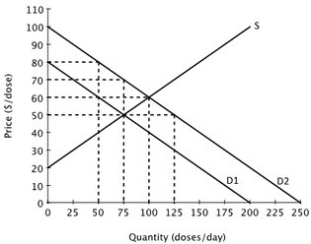 The private demand for the vaccine is given by ________, and social demand for the vaccine is given by ________.
The private demand for the vaccine is given by ________, and social demand for the vaccine is given by ________.
A)D1; MC
B)D2; MC
C)D1; D2
D)D2; D1
 The private demand for the vaccine is given by ________, and social demand for the vaccine is given by ________.
The private demand for the vaccine is given by ________, and social demand for the vaccine is given by ________.A)D1; MC
B)D2; MC
C)D1; D2
D)D2; D1

Unlock Deck
Unlock for access to all 184 flashcards in this deck.
Unlock Deck
k this deck
29
Suppose that a vaccine is developed for a highly contagious strain of flu. The likelihood that anyone will get this flu decreases as more people receive the vaccine. One of the demand curves below represents the private demand for the vaccine and the other represents the social demand for the vaccine. 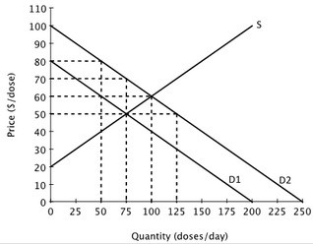 The socially optimal quantity of the vaccine is ________ doses per day.
The socially optimal quantity of the vaccine is ________ doses per day.
A)50
B)75
C)100
D)125
 The socially optimal quantity of the vaccine is ________ doses per day.
The socially optimal quantity of the vaccine is ________ doses per day.A)50
B)75
C)100
D)125

Unlock Deck
Unlock for access to all 184 flashcards in this deck.
Unlock Deck
k this deck
30
The insight that people can always arrive at efficient solutions to the problems caused by externalities if they can negotiate the purchase and sale of the right to perform activities that cause externalities is called the ________.
A)Sherman Act
B)Coase Theorem
C)tragedy of the commons
D)prisoner's dilemma
A)Sherman Act
B)Coase Theorem
C)tragedy of the commons
D)prisoner's dilemma

Unlock Deck
Unlock for access to all 184 flashcards in this deck.
Unlock Deck
k this deck
31
An external benefit implies that private markets will provide ________ than the socially optimal quantity, and an external cost implies that private markets will provide ________ than the socially optimal quantity.
A)more; more
B)less; less
C)more; less
D)less; more
A)more; more
B)less; less
C)more; less
D)less; more

Unlock Deck
Unlock for access to all 184 flashcards in this deck.
Unlock Deck
k this deck
32
Refer to the figure below. This graph describes a good that: 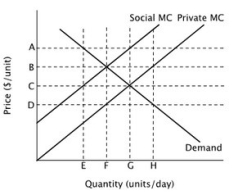
A)generates positive externalities.
B)should be banned.
C)generates negative externalities.
D)the government should subsidize.

A)generates positive externalities.
B)should be banned.
C)generates negative externalities.
D)the government should subsidize.

Unlock Deck
Unlock for access to all 184 flashcards in this deck.
Unlock Deck
k this deck
33
Kate and Ali can live together in a two-bedroom apartment for $600 per month, or they can each rent a one-bedroom apartment for $400 per month. Apart from the rent, they are indifferent between living together and living apart, except for one problem: Kate hates Ali's taste in music. Kate would be willing to pay up to $100 a month to avoid hearing Ali's music. Ali would give up listening to her music for no less than $300 per month. Which, if any, of the following ways of splitting the total monthly rent would induce them to live together?
A)Kate pays $150 per month and Ali pays $450 per month
B)Kate pays $250 per month and Ali pays $350 per month
C)Kate pays $375 per month and Ali pays $125 per month
D)There is no way to split the rent to induce them to live together
A)Kate pays $150 per month and Ali pays $450 per month
B)Kate pays $250 per month and Ali pays $350 per month
C)Kate pays $375 per month and Ali pays $125 per month
D)There is no way to split the rent to induce them to live together

Unlock Deck
Unlock for access to all 184 flashcards in this deck.
Unlock Deck
k this deck
34
Suppose that a vaccine is developed for a highly contagious strain of flu. The likelihood that anyone will get this flu decreases as more people receive the vaccine. One of the demand curves below represents the private demand for the vaccine and the other represents the social demand for the vaccine. 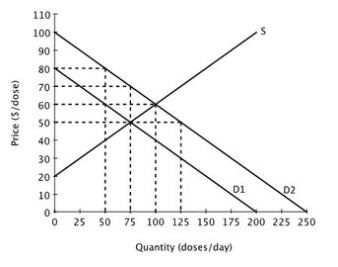 At the private market equilibrium, the price of each dose is:
At the private market equilibrium, the price of each dose is:
A)$50.
B)$60.
C)$70.
D)$80.
 At the private market equilibrium, the price of each dose is:
At the private market equilibrium, the price of each dose is:A)$50.
B)$60.
C)$70.
D)$80.

Unlock Deck
Unlock for access to all 184 flashcards in this deck.
Unlock Deck
k this deck
35
Consider two restaurants located next door to each other: Quick Burger and The Sunshine Café. If Quick Burger opens a drive-through window, the increased traffic and noise will bother customers seated outside at The Sunshine Café. The table below shows the monthly payoffs to Quick Burger and The Sunshine Café when Quick Burger does and does not operate a drive-through window.
If Quick Burger has the legal right to operate a drive-through window, then the Sunshine Café would have to pay Quick Burger at least ________ per month to NOT operate a drive-through window.
A)$9,000
B)$11,000
C)$15,000
D)$24,000
If Quick Burger has the legal right to operate a drive-through window, then the Sunshine Café would have to pay Quick Burger at least ________ per month to NOT operate a drive-through window.
A)$9,000
B)$11,000
C)$15,000
D)$24,000

Unlock Deck
Unlock for access to all 184 flashcards in this deck.
Unlock Deck
k this deck
36
Refer to the figure below. Private markets will provide ________ units of this good per day, and the socially optimal number of units per day is ________.
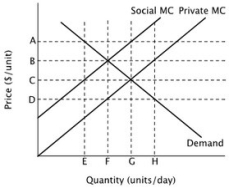
A)H; F
B)H; G
C)F; G
D)G; F

A)H; F
B)H; G
C)F; G
D)G; F

Unlock Deck
Unlock for access to all 184 flashcards in this deck.
Unlock Deck
k this deck
37
Suppose that a vaccine is developed for a highly contagious strain of flu. The likelihood that anyone will get this flu decreases as more people receive the vaccine. One of the demand curves below represents the private demand for the vaccine and the other represents the social demand for the vaccine. 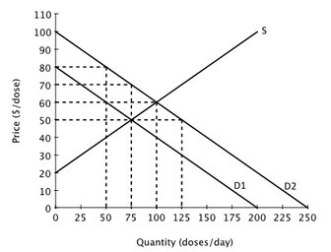 At the private market equilibrium, the deadweight loss is ________ per day.
At the private market equilibrium, the deadweight loss is ________ per day.
A)$0
B)$125
C)$250
D)$500
 At the private market equilibrium, the deadweight loss is ________ per day.
At the private market equilibrium, the deadweight loss is ________ per day.A)$0
B)$125
C)$250
D)$500

Unlock Deck
Unlock for access to all 184 flashcards in this deck.
Unlock Deck
k this deck
38
Suppose that a vaccine is developed for a highly contagious strain of flu. The likelihood that anyone will get this flu decreases as more people receive the vaccine. One of the demand curves below represents the private demand for the vaccine and the other represents the social demand for the vaccine. 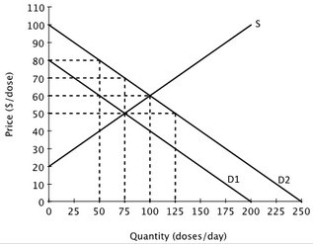 The private market equilibrium quantity is ________ doses per day.
The private market equilibrium quantity is ________ doses per day.
A)50
B)75
C)100
D)125
 The private market equilibrium quantity is ________ doses per day.
The private market equilibrium quantity is ________ doses per day.A)50
B)75
C)100
D)125

Unlock Deck
Unlock for access to all 184 flashcards in this deck.
Unlock Deck
k this deck
39
Kate and Ali can live together in a two-bedroom apartment for $600 per month, or they can each rent a one-bedroom apartment for $400 per month. Apart from the rent, they are indifferent between living together and living apart, except for one problem: Kate hates Ali's taste in music. Kate would be willing to pay up to $100 a month to avoid hearing Ali's music. Ali would give up listening to her music for no less than $300 per month. If Kate and Ali decide to live together, is it socially optimal for Ali to play her music in the apartment?
A)Yes, because the benefit to Ali of listening to her music is greater than the cost to Kate.
B)No, because the benefit to Ali of listening to her music is less than the cost to Kate.
C)Yes, because the benefit to Ali of listening to her music is less than the cost to Kate.
D)No, because the benefit to Ali of listening to her music is greater than the cost to Kate.
A)Yes, because the benefit to Ali of listening to her music is greater than the cost to Kate.
B)No, because the benefit to Ali of listening to her music is less than the cost to Kate.
C)Yes, because the benefit to Ali of listening to her music is less than the cost to Kate.
D)No, because the benefit to Ali of listening to her music is greater than the cost to Kate.

Unlock Deck
Unlock for access to all 184 flashcards in this deck.
Unlock Deck
k this deck
40
Consider two restaurants located next door to each other: Quick Burger and The Sunshine Café. If Quick Burger opens a drive-through window, the increased traffic and noise will bother customers seated outside at The Sunshine Café. The table below shows the monthly payoffs to Quick Burger and The Sunshine Café when Quick Burger does and does not operate a drive-through window. If Quick Burger has the legal right to operate a drive-through, and Quick Burger and The Sunshine Café CANNOT negotiate with each other, then will Quick Burger operate a drive-through window?
A)No, because it is not socially efficient to operate a drive-through.
B)Yes, because Quick Burger's payoff is higher when it operates a drive-through.
C)No, because it would lower the payoff for The Sunshine Café.
D)It cannot be determined.
A)No, because it is not socially efficient to operate a drive-through.
B)Yes, because Quick Burger's payoff is higher when it operates a drive-through.
C)No, because it would lower the payoff for The Sunshine Café.
D)It cannot be determined.

Unlock Deck
Unlock for access to all 184 flashcards in this deck.
Unlock Deck
k this deck
41
Suppose Erie Textiles can dispose of its waste "for free" by dumping it into a nearby river. While the firm benefits from dumping waste into the river, the waste reduces fish and bird reproduction. This causes damage to local fishermen and bird watchers. At a cost, Erie Textiles can filter out the toxins, in which case local fishermen and bird watchers will not suffer any damage. The relevant gains and losses (in thousands of dollars)for the three parties are listed below.
 When Erie Textiles operates without a filter, the total gain (in thousands of dollars)to all three parties is ________.
When Erie Textiles operates without a filter, the total gain (in thousands of dollars)to all three parties is ________.
A)$985
B)$325
C)$510
D)$475
 When Erie Textiles operates without a filter, the total gain (in thousands of dollars)to all three parties is ________.
When Erie Textiles operates without a filter, the total gain (in thousands of dollars)to all three parties is ________.A)$985
B)$325
C)$510
D)$475

Unlock Deck
Unlock for access to all 184 flashcards in this deck.
Unlock Deck
k this deck
42
Suppose Oscar and Felix share an apartment. Oscar likes to leave his dirty dishes in the sink, and this really bothers Felix. When Oscar leaves his dirty dishes in the sink, Oscar's surplus from their living arrangement is $400 per month, and Felix's surplus is $300 per month. On the other hand, when Oscar does not leave his dirty dishes in the sink, Oscar's surplus from their living arrangement is $350 per month, and Felix's surplus is $325 per month. There are no rules or regulations that prevent Oscar from leaving his dishes in the sink. In this case, the socially optimal outcome can be achieved:
A)if Felix gives Oscar $25 per month to stop leaving his dishes in the sink.
B)if Felix gives Oscar $50 per month to stop leaving his dishes in the sink.
C)if Felix gives Oscar more than $75 per month to stop leaving his dishes in the sink.
D)without any intervention.
A)if Felix gives Oscar $25 per month to stop leaving his dishes in the sink.
B)if Felix gives Oscar $50 per month to stop leaving his dishes in the sink.
C)if Felix gives Oscar more than $75 per month to stop leaving his dishes in the sink.
D)without any intervention.

Unlock Deck
Unlock for access to all 184 flashcards in this deck.
Unlock Deck
k this deck
43
Suppose there are ten people playing cards in a room. One of them wants to smoke a cigar, nine of them dislike the smell of cigar smoke. The smoker values the privilege of smoking at $5, and each of the other nine people of the room would be willing to pay fifty cents for clean air in the room. The rules governing use of the room state that smoking is not allowed unless everyone agrees to allow smoking. If the rules governing the room instead stated that smoking is allowed unless everyone in the room agrees to prohibit it, then:
A)the non-smoking occupants will pay the cigar smoker to not smoke.
B)the cigar smoker will smoke and not have to pay the other occupants for the external cost.
C)the cigar smoker will smoke, and will pay each other occupant 50 cents.
D)the parties may or may not be able to reach a negotiated agreement depending on the bargaining strength of each.
A)the non-smoking occupants will pay the cigar smoker to not smoke.
B)the cigar smoker will smoke and not have to pay the other occupants for the external cost.
C)the cigar smoker will smoke, and will pay each other occupant 50 cents.
D)the parties may or may not be able to reach a negotiated agreement depending on the bargaining strength of each.

Unlock Deck
Unlock for access to all 184 flashcards in this deck.
Unlock Deck
k this deck
44
Suppose Erie Textiles can dispose of its waste "for free" by dumping it into a nearby river. While the firm benefits from dumping waste into the river, the waste reduces fish and bird reproduction. This causes damage to local fishermen and bird watchers. At a cost, Erie Textiles can filter out the toxins, in which case local fishermen and bird watchers will not suffer any damage. The relevant gains and losses (in thousands of dollars)for the three parties are listed below.  The cost (in thousands of dollars)of the filter to Erie Textiles is ________, and the net benefit (in thousands of dollars)of the filter to the fishermen and bird watchers is ________.
The cost (in thousands of dollars)of the filter to Erie Textiles is ________, and the net benefit (in thousands of dollars)of the filter to the fishermen and bird watchers is ________.
A)$400; $310
B)$310; $200
C)$200; $75
D)$200; $235
 The cost (in thousands of dollars)of the filter to Erie Textiles is ________, and the net benefit (in thousands of dollars)of the filter to the fishermen and bird watchers is ________.
The cost (in thousands of dollars)of the filter to Erie Textiles is ________, and the net benefit (in thousands of dollars)of the filter to the fishermen and bird watchers is ________.A)$400; $310
B)$310; $200
C)$200; $75
D)$200; $235

Unlock Deck
Unlock for access to all 184 flashcards in this deck.
Unlock Deck
k this deck
45
Consider two restaurants located next door to each other: Quick Burger and The Sunshine Café. If Quick Burger opens a drive-through window, the increased traffic and noise will bother customers seated outside at The Sunshine Café. The table below shows the monthly payoffs to Quick Burger and The Sunshine Café when Quick Burger does and does not operate a drive-through window.
Suppose Quick Burger has the legal right to operate a drive-through window, and Quick Burger and the Sunshine Café can negotiate with each other at no cost. Which of the following arrangements would lead to the socially optimal outcome?
A)Quick Burger pays The Sunshine Café $12,500 per month to operate the drive-through window.
B)Quick Burger pays The Sunshine Café $10,500 per month to operate the drive-through window.
C)The Sunshine Café pays Quick Burger $12,500 per month not to operate the drive-through window.
D)The Sunshine Café pays Quick Burger $10,500 per month not to operate the drive-through window.
Suppose Quick Burger has the legal right to operate a drive-through window, and Quick Burger and the Sunshine Café can negotiate with each other at no cost. Which of the following arrangements would lead to the socially optimal outcome?
A)Quick Burger pays The Sunshine Café $12,500 per month to operate the drive-through window.
B)Quick Burger pays The Sunshine Café $10,500 per month to operate the drive-through window.
C)The Sunshine Café pays Quick Burger $12,500 per month not to operate the drive-through window.
D)The Sunshine Café pays Quick Burger $10,500 per month not to operate the drive-through window.

Unlock Deck
Unlock for access to all 184 flashcards in this deck.
Unlock Deck
k this deck
46
Suppose there are ten people playing cards in a room. One of them wants to smoke a cigar, nine of them dislike the smell of cigar smoke. The smoker values the privilege of smoking at $5, and each of the other nine people of the room would be willing to pay fifty cents for clean air in the room. The rules governing use of the room state that smoking is not allowed unless everyone agrees to allow smoking. If the cigar smoker paid each other occupant fifty cents for the right to smoke, the cigar smoker would be ________ and the other occupants would be ________.
A)better off; worse off
B)better off; just as well off as before the payment
C)better off; better off
D)worse off; just as well off as before the payment
A)better off; worse off
B)better off; just as well off as before the payment
C)better off; better off
D)worse off; just as well off as before the payment

Unlock Deck
Unlock for access to all 184 flashcards in this deck.
Unlock Deck
k this deck
47
Curly and Moe are considering living alone or being roommates and splitting the rent for the next twelve months. If they live alone, they each rent a one bedroom, one bath apartment for $500 per month, while if they are roommates, they can split a two bedroom, one bath apartment for $800 per month. The one difficulty they have is that Moe snores very loudly. Curly estimates the cost of poor sleep due to Moe's snoring at $150 per month. Moe could obtain a snore-eliminating device for $50 per month. Curly would be willing to pay ________ per month to eliminate Moe's snoring.
A)exactly $50
B)no more than $100
C)up to $150
D)nothing
A)exactly $50
B)no more than $100
C)up to $150
D)nothing

Unlock Deck
Unlock for access to all 184 flashcards in this deck.
Unlock Deck
k this deck
48
The Coase theorem implies that the initial allocation of property rights:
A)determines all aspects of the final outcome of the negotiated agreement.
B)does not determine which person will be entitled to engage in the externality generating activity, but does determine which person will receive compensation.
C)determines which person will be entitled to engage in the externality generating activity, but does not affect which person will receive compensation.
D)must be assigned to the person with the greatest costs.
A)determines all aspects of the final outcome of the negotiated agreement.
B)does not determine which person will be entitled to engage in the externality generating activity, but does determine which person will receive compensation.
C)determines which person will be entitled to engage in the externality generating activity, but does not affect which person will receive compensation.
D)must be assigned to the person with the greatest costs.

Unlock Deck
Unlock for access to all 184 flashcards in this deck.
Unlock Deck
k this deck
49
Suppose Erie Textiles can dispose of its waste "for free" by dumping it into a nearby river. While the firm benefits from dumping waste into the river, the waste reduces fish and bird reproduction. This causes damage to local fishermen and bird watchers. At a cost, Erie Textiles can filter out the toxins, in which case local fishermen and bird watchers will not suffer any damage. The relevant gains and losses (in thousands of dollars)for the three parties are listed below.  Local fishermen and bird watchers would be willing to compensate Erie Textiles ________ for operating with a filter.
Local fishermen and bird watchers would be willing to compensate Erie Textiles ________ for operating with a filter.
A)up to $310,000
B)no more than $235,000
C)no more than $75,000
D)nothing
 Local fishermen and bird watchers would be willing to compensate Erie Textiles ________ for operating with a filter.
Local fishermen and bird watchers would be willing to compensate Erie Textiles ________ for operating with a filter.A)up to $310,000
B)no more than $235,000
C)no more than $75,000
D)nothing

Unlock Deck
Unlock for access to all 184 flashcards in this deck.
Unlock Deck
k this deck
50
Suppose there are ten people playing cards in a room. One of them wants to smoke a cigar, nine of them dislike the smell of cigar smoke. The smoker values the privilege of smoking at $5, and each of the other nine people of the room would be willing to pay fifty cents for clean air in the room. The rules governing use of the room state that smoking is not allowed unless everyone agrees to allow smoking. If all ten people can negotiate with each other at no cost, then the Coase theorem predicts that if the cigar smoker has the right to determine whether smoking is allowed, then there ________ be smoking, and if the other nine people in the room have the right to determine whether smoking is allowed, then there ________ be smoking.
A)will; will
B)will; will not
C)will not; will not
D)will not; will
A)will; will
B)will; will not
C)will not; will not
D)will not; will

Unlock Deck
Unlock for access to all 184 flashcards in this deck.
Unlock Deck
k this deck
51
Suppose there are ten people playing cards in a room. One of them wants to smoke a cigar, nine of them dislike the smell of cigar smoke. The smoker values the privilege of smoking at $5, and each of the other nine people of the room would be willing to pay fifty cents for clean air in the room. The rules governing use of the room state that smoking is not allowed unless everyone agrees to allow smoking. If all ten people can negotiate with each other at no cost, then which of the following outcomes is consistent with the Coase theorem?
A)The cigar smoker will not be able to smoke because the majority of people in the room dislike the smell of cigar smoke.
B)The cigar smoker will pay each of the other nine people fifty-five cents, and they will agree to allow smoking.
C)The cigar smoker will smoke because the external cost of smoking does not need to be taken into consideration.
D)The nine non-smokers will each pay the cigar smoker fifty cents and the cigar smoker will not smoke.
A)The cigar smoker will not be able to smoke because the majority of people in the room dislike the smell of cigar smoke.
B)The cigar smoker will pay each of the other nine people fifty-five cents, and they will agree to allow smoking.
C)The cigar smoker will smoke because the external cost of smoking does not need to be taken into consideration.
D)The nine non-smokers will each pay the cigar smoker fifty cents and the cigar smoker will not smoke.

Unlock Deck
Unlock for access to all 184 flashcards in this deck.
Unlock Deck
k this deck
52
Curly and Moe are considering living alone or being roommates and splitting the rent for the next twelve months. If they live alone, they each rent a one bedroom, one bath apartment for $500 per month, while if they are roommates, they can split a two bedroom, one bath apartment for $800 per month. The one difficulty they have is that Moe snores very loudly. Curly estimates the cost of poor sleep due to Moe's snoring at $150 per month. Moe could obtain a snore-eliminating device for $50 per month. The actual monthly gain in surplus to Curly and Moe from living together after addressing the snoring problems in the least costly way is:
A)$200.
B)$150.
C)$100.
D)$50.
A)$200.
B)$150.
C)$100.
D)$50.

Unlock Deck
Unlock for access to all 184 flashcards in this deck.
Unlock Deck
k this deck
53
Curly and Moe are considering living alone or being roommates and splitting the rent for the next twelve months. If they live alone, they each rent a one bedroom, one bath apartment for $500 per month, while if they are roommates, they can split a two bedroom, one bath apartment for $800 per month. The one difficulty they have is that Moe snores very loudly. Curly estimates the cost of poor sleep due to Moe's snoring at $150 per month. Moe could obtain a snore-eliminating device for $50 per month. Curly and Moe have both taken an economics course and so are willing to apply the Coase theorem and negotiate. Who will compensate the other?
A)Neither Moe nor Curly has the initial property right, and so neither will compensate the other.
B)Moe must compensate Curly because Moe is the one who is snoring.
C)Curly must compensate Moe because Curly is the one who is bothered by the snoring.
D)Either Moe will compensate Curly or Curly will compensate Moe because the alternative, renting separate apartments, leaves each worse off.
A)Neither Moe nor Curly has the initial property right, and so neither will compensate the other.
B)Moe must compensate Curly because Moe is the one who is snoring.
C)Curly must compensate Moe because Curly is the one who is bothered by the snoring.
D)Either Moe will compensate Curly or Curly will compensate Moe because the alternative, renting separate apartments, leaves each worse off.

Unlock Deck
Unlock for access to all 184 flashcards in this deck.
Unlock Deck
k this deck
54
Suppose there are ten people playing cards in a room. One of them wants to smoke a cigar, nine of them dislike the smell of cigar smoke. The smoker values the privilege of smoking at $5, and each of the other nine people of the room would be willing to pay fifty cents for clean air in the room. The rules governing use of the room state that smoking is not allowed unless everyone agrees to allow smoking. Is it socially optimal for the cigar smoker to smoke?
A)No, because the majority of people in the room dislike the smell of cigar smoke.
B)No, because the value to the cigar smoker of smoking is less than the total value to the other people in the room of clean air.
C)Yes, because the value to the cigar smoker of smoking is greater than the total value to the other people in the room of clean air.
D)Yes, because the value to the cigar smoker of smoking is greater than 50 cents.
A)No, because the majority of people in the room dislike the smell of cigar smoke.
B)No, because the value to the cigar smoker of smoking is less than the total value to the other people in the room of clean air.
C)Yes, because the value to the cigar smoker of smoking is greater than the total value to the other people in the room of clean air.
D)Yes, because the value to the cigar smoker of smoking is greater than 50 cents.

Unlock Deck
Unlock for access to all 184 flashcards in this deck.
Unlock Deck
k this deck
55
Suppose there are ten people playing cards in a room. One of them wants to smoke a cigar, nine of them dislike the smell of cigar smoke. The smoker values the privilege of smoking at $5, and each of the other nine people of the room would be willing to pay fifty cents for clean air in the room. The rules governing use of the room state that smoking is not allowed unless everyone agrees to allow smoking. Declaring the card room a non-smoking area with no opportunity to negotiate would:
A)decrease total economic surplus.
B)increase total economic surplus.
C)leave total economic surplus unchanged, but redistribute benefits.
D)efficiently solve the externality problem.
A)decrease total economic surplus.
B)increase total economic surplus.
C)leave total economic surplus unchanged, but redistribute benefits.
D)efficiently solve the externality problem.

Unlock Deck
Unlock for access to all 184 flashcards in this deck.
Unlock Deck
k this deck
56
Suppose that your neighbor smokes in his yard. You can smell his cigarette smoke from inside your house, and you dislike the smell. Which of the following statements is correct?
A)If it is difficult for you and your neighbor to negotiate with each other, then you may not be able to arrive at an efficient solution to this problem.
B)Since your neighbor has the legal right to smoke in his yard, you will not be able to arrive at an efficient solution to this problem.
C)It not socially optimal for your neighbor to smoke in his yard.
D)There is no efficient solution to this problem.
A)If it is difficult for you and your neighbor to negotiate with each other, then you may not be able to arrive at an efficient solution to this problem.
B)Since your neighbor has the legal right to smoke in his yard, you will not be able to arrive at an efficient solution to this problem.
C)It not socially optimal for your neighbor to smoke in his yard.
D)There is no efficient solution to this problem.

Unlock Deck
Unlock for access to all 184 flashcards in this deck.
Unlock Deck
k this deck
57
Suppose Erie Textiles can dispose of its waste "for free" by dumping it into a nearby river. While the firm benefits from dumping waste into the river, the waste reduces fish and bird reproduction. This causes damage to local fishermen and bird watchers. At a cost, Erie Textiles can filter out the toxins, in which case local fishermen and bird watchers will not suffer any damage. The relevant gains and losses (in thousands of dollars)for the three parties are listed below.  When Erie Textiles operates with a filter, the total gain (in thousands of dollars)by all three parties is ________.
When Erie Textiles operates with a filter, the total gain (in thousands of dollars)by all three parties is ________.
A)$985
B)$600
C)$510
D)$475
 When Erie Textiles operates with a filter, the total gain (in thousands of dollars)by all three parties is ________.
When Erie Textiles operates with a filter, the total gain (in thousands of dollars)by all three parties is ________.A)$985
B)$600
C)$510
D)$475

Unlock Deck
Unlock for access to all 184 flashcards in this deck.
Unlock Deck
k this deck
58
Suppose Erie Textiles can dispose of its waste "for free" by dumping it into a nearby river. While the firm benefits from dumping waste into the river, the waste reduces fish and bird reproduction. This causes damage to local fishermen and bird watchers. At a cost, Erie Textiles can filter out the toxins, in which case local fishermen and bird watchers will not suffer any damage. The relevant gains and losses (in thousands of dollars)for the three parties are listed below.
 If Erie Textiles does not install the filter, there will be a net social ________ of ________ (in thousands of dollars).
If Erie Textiles does not install the filter, there will be a net social ________ of ________ (in thousands of dollars).
A)loss; $35
B)gain; $75
C)loss; $110
D)gain; $200
 If Erie Textiles does not install the filter, there will be a net social ________ of ________ (in thousands of dollars).
If Erie Textiles does not install the filter, there will be a net social ________ of ________ (in thousands of dollars).A)loss; $35
B)gain; $75
C)loss; $110
D)gain; $200

Unlock Deck
Unlock for access to all 184 flashcards in this deck.
Unlock Deck
k this deck
59
Curly and Moe are considering living alone or being roommates and splitting the rent for the next twelve months. If they live alone, they each rent a one bedroom, one bath apartment for $500 per month, while if they are roommates, they can split a two bedroom, one bath apartment for $800 per month. The one difficulty they have is that Moe snores very loudly. Curly estimates the cost of poor sleep due to Moe's snoring at $150 per month. Moe could obtain a snore-eliminating device for $50 per month. The least costly solution to the externality present in this situation is for:
A)Curly to endure Moe's snoring.
B)both to live alone.
C)Moe to eliminate his snoring.
D)Moe to pay Curly for his discomfort.
A)Curly to endure Moe's snoring.
B)both to live alone.
C)Moe to eliminate his snoring.
D)Moe to pay Curly for his discomfort.

Unlock Deck
Unlock for access to all 184 flashcards in this deck.
Unlock Deck
k this deck
60
Suppose Erie Textiles can dispose of its waste "for free" by dumping it into a nearby river. While the firm benefits from dumping waste into the river, the waste reduces fish and bird reproduction. This causes damage to local fishermen and bird watchers. At a cost, Erie Textiles can filter out the toxins, in which case local fishermen and bird watchers will not suffer any damage. The relevant gains and losses (in thousands of dollars)for the three parties are listed below.
 If all three parties can communicate and negotiate with each other at no cost, will Erie Textiles use a filter?
If all three parties can communicate and negotiate with each other at no cost, will Erie Textiles use a filter?
A)No, because it makes $200 less in profit with the filter.
B)Yes, because the benefit it would receive from being able to advertise that it acts in an environmentally responsible way exceeds the cost of using a filter.
C)No, because use of a filter would result in smaller total economic surplus.
D)Yes, because fishermen and bird watchers are willing to pay enough to Erie Textiles to offset the cost of using a filter.
 If all three parties can communicate and negotiate with each other at no cost, will Erie Textiles use a filter?
If all three parties can communicate and negotiate with each other at no cost, will Erie Textiles use a filter?A)No, because it makes $200 less in profit with the filter.
B)Yes, because the benefit it would receive from being able to advertise that it acts in an environmentally responsible way exceeds the cost of using a filter.
C)No, because use of a filter would result in smaller total economic surplus.
D)Yes, because fishermen and bird watchers are willing to pay enough to Erie Textiles to offset the cost of using a filter.

Unlock Deck
Unlock for access to all 184 flashcards in this deck.
Unlock Deck
k this deck
61
In order to achieve the socially optimal level of output, goods that entail positive externalities should be:
A)required.
B)subsidized.
C)taxed.
D)deregulated.
A)required.
B)subsidized.
C)taxed.
D)deregulated.

Unlock Deck
Unlock for access to all 184 flashcards in this deck.
Unlock Deck
k this deck
62
A policy maker has argued for higher taxes on gasoline to reduce the negative externalities associated with driving. This policy will lead to a relatively ________ reduction in driving if demand is ________.
A)small; perfectly elastic
B)large; perfectly inelastic
C)small; relatively inelastic
D)large; relatively inelastic
A)small; perfectly elastic
B)large; perfectly inelastic
C)small; relatively inelastic
D)large; relatively inelastic

Unlock Deck
Unlock for access to all 184 flashcards in this deck.
Unlock Deck
k this deck
63
This graph shows the marginal cost and marginal benefit associated with roadside litter clean up. Assume that the marginal benefit curve and marginal cost curve each have their usual slope. 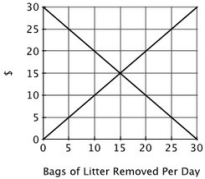 According to this graph, the marginal benefit of litter removal is highest when the ________ bag of litter is removed.
According to this graph, the marginal benefit of litter removal is highest when the ________ bag of litter is removed.
A)1st
B)10th
C)15th
D)30th
 According to this graph, the marginal benefit of litter removal is highest when the ________ bag of litter is removed.
According to this graph, the marginal benefit of litter removal is highest when the ________ bag of litter is removed.A)1st
B)10th
C)15th
D)30th

Unlock Deck
Unlock for access to all 184 flashcards in this deck.
Unlock Deck
k this deck
64
Suppose Erie Textiles can dispose of its waste "for free" by dumping it into a nearby river. While the firm benefits from dumping waste into the river, the waste reduces fish and bird reproduction. This causes damage to local fishermen and bird watchers. At a cost, Erie Textiles can filter out the toxins, in which case local fishermen and bird watchers will not suffer any damage. The relevant gains and losses (in thousands of dollars)for the three parties are listed below. 
Suppose that Erie Textiles can only negotiate with one of the affected groups. Will Erie operate with a filter?
A)Yes, if they negotiate with the Bird Watchers, but not if they negotiate with the Fishermen.
B)No, regardless of which group they negotiate with.
C)Yes, if they negotiate with the Fishermen, but not if they negotiate with the Bird Watchers.
D)Yes, regardless of which group they negotiate with.

Suppose that Erie Textiles can only negotiate with one of the affected groups. Will Erie operate with a filter?
A)Yes, if they negotiate with the Bird Watchers, but not if they negotiate with the Fishermen.
B)No, regardless of which group they negotiate with.
C)Yes, if they negotiate with the Fishermen, but not if they negotiate with the Bird Watchers.
D)Yes, regardless of which group they negotiate with.

Unlock Deck
Unlock for access to all 184 flashcards in this deck.
Unlock Deck
k this deck
65
This graph shows the marginal cost and marginal benefit associated with roadside litter clean up. Assume that the marginal benefit curve and marginal cost curve each have their usual slope. 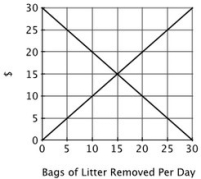 A state initiative requiring towns to spend at least $20 per day on litter removal would be ________ because ________.
A state initiative requiring towns to spend at least $20 per day on litter removal would be ________ because ________.
A)efficient; reducing litter is socially optimal
B)inefficient; the marginal cost of litter removal would exceed the marginal benefit
C)inefficient; $20 is insufficient to remove all of the litter
D)efficient; it solves the inefficiency created by the negative externality
 A state initiative requiring towns to spend at least $20 per day on litter removal would be ________ because ________.
A state initiative requiring towns to spend at least $20 per day on litter removal would be ________ because ________.A)efficient; reducing litter is socially optimal
B)inefficient; the marginal cost of litter removal would exceed the marginal benefit
C)inefficient; $20 is insufficient to remove all of the litter
D)efficient; it solves the inefficiency created by the negative externality

Unlock Deck
Unlock for access to all 184 flashcards in this deck.
Unlock Deck
k this deck
66
Which one of the following government actions is intended to generate positive externalities?
A)Taxing polluting industries
B)Speed limits on the highways
C)Requiring autos to meet minimum emissions regulations
D)Subsidies for planting trees on hillsides
A)Taxing polluting industries
B)Speed limits on the highways
C)Requiring autos to meet minimum emissions regulations
D)Subsidies for planting trees on hillsides

Unlock Deck
Unlock for access to all 184 flashcards in this deck.
Unlock Deck
k this deck
67
In order to achieve the socially optimal level of output, goods that entail negative externalities should be:
A)banned.
B)subsidized.
C)taxed.
D)provided by the government.
A)banned.
B)subsidized.
C)taxed.
D)provided by the government.

Unlock Deck
Unlock for access to all 184 flashcards in this deck.
Unlock Deck
k this deck
68
This graph shows the marginal cost and marginal benefit associated with roadside litter clean up. Assume that the marginal benefit curve and marginal cost curve each have their usual slope. 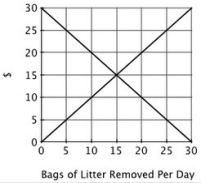 The marginal cost of litter removal ________ due to ________.
The marginal cost of litter removal ________ due to ________.
A)decreases; gains from specialization
B)increases; the Coase Theorem
C)increases; increasing opportunity costs
D)decreases; diminishing returns to inputs
 The marginal cost of litter removal ________ due to ________.
The marginal cost of litter removal ________ due to ________.A)decreases; gains from specialization
B)increases; the Coase Theorem
C)increases; increasing opportunity costs
D)decreases; diminishing returns to inputs

Unlock Deck
Unlock for access to all 184 flashcards in this deck.
Unlock Deck
k this deck
69
This graph shows the marginal cost and marginal benefit associated with roadside litter clean up. Assume that the marginal benefit curve and marginal cost curve each have their usual slope. 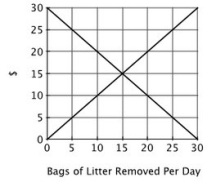 Picking up the 20th bag of litter would:
Picking up the 20th bag of litter would:
A)be socially efficient.
B)increase total economic surplus.
C)create deadweight loss.
D)be socially efficient, but would not be consistent with the actions of self-interested individuals.
 Picking up the 20th bag of litter would:
Picking up the 20th bag of litter would:A)be socially efficient.
B)increase total economic surplus.
C)create deadweight loss.
D)be socially efficient, but would not be consistent with the actions of self-interested individuals.

Unlock Deck
Unlock for access to all 184 flashcards in this deck.
Unlock Deck
k this deck
70
If the marginal cost of reducing pollution is positive, then:
A)pollution should be reduced as much as technically feasible.
B)the marginal benefit of reducing pollution is zero.
C)the optimal amount of pollution is zero.
D)the optimal amount of pollution is greater than zero.
A)pollution should be reduced as much as technically feasible.
B)the marginal benefit of reducing pollution is zero.
C)the optimal amount of pollution is zero.
D)the optimal amount of pollution is greater than zero.

Unlock Deck
Unlock for access to all 184 flashcards in this deck.
Unlock Deck
k this deck
71
This graph shows the marginal cost and marginal benefit associated with roadside litter clean up. Assume that the marginal benefit curve and marginal cost curve each have their usual slope. 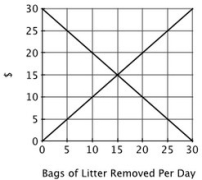 The socially optimal number of bags of litter removed from the roadside each day is:
The socially optimal number of bags of litter removed from the roadside each day is:
A)10.
B)15.
C)20.
D)30.
 The socially optimal number of bags of litter removed from the roadside each day is:
The socially optimal number of bags of litter removed from the roadside each day is:A)10.
B)15.
C)20.
D)30.

Unlock Deck
Unlock for access to all 184 flashcards in this deck.
Unlock Deck
k this deck
72
Suppose Erie Textiles can dispose of its waste "for free" by dumping it into a nearby river. While the firm benefits from dumping waste into the river, the waste reduces fish and bird reproduction. This causes damage to local fishermen and bird watchers. At a cost, Erie Textiles can filter out the toxins, in which case local fishermen and bird watchers will not suffer any damage. The relevant gains and losses (in thousands of dollars)for the three parties are listed below.
 Suppose you observe that Erie has not added a filter. You could conclude that the Coase theorem failed to solve the externality problem because:
Suppose you observe that Erie has not added a filter. You could conclude that the Coase theorem failed to solve the externality problem because:
A)Erie's benefits to operating without a filter are greater than the benefits of a filter to the fishermen and bird watchers.
B)negotiation with many individual fishermen and bird watchers was too costly.
C)Erie has a property right to the river.
D)regulators prevent application of the Coase theorem when the environment is at stake.
 Suppose you observe that Erie has not added a filter. You could conclude that the Coase theorem failed to solve the externality problem because:
Suppose you observe that Erie has not added a filter. You could conclude that the Coase theorem failed to solve the externality problem because:A)Erie's benefits to operating without a filter are greater than the benefits of a filter to the fishermen and bird watchers.
B)negotiation with many individual fishermen and bird watchers was too costly.
C)Erie has a property right to the river.
D)regulators prevent application of the Coase theorem when the environment is at stake.

Unlock Deck
Unlock for access to all 184 flashcards in this deck.
Unlock Deck
k this deck
73
Suppose that the EPA has proposed strict controls on the amount of sulfur that diesel fuel contains. These controls were designed to fully offset the cost of pollution generated by diesel fuel vehicles. The effect of the regulation is estimated to increase the equilibrium price of a gallon of diesel fuel by 10 cents. Assuming that the supply of diesel fuel has a positive slope and demand has a negative slope, the quantity of diesel fuel sold after imposition of the regulation will:
A)remain the same.
B)increase.
C)decrease.
D)decrease only if diesel fuel is a normal good.
A)remain the same.
B)increase.
C)decrease.
D)decrease only if diesel fuel is a normal good.

Unlock Deck
Unlock for access to all 184 flashcards in this deck.
Unlock Deck
k this deck
74
The optimal quantity of a negative externality is zero if:
A)it imposes a high enough cost on society.
B)it is costly for people to negotiate with each other.
C)the majority of voters decide to eliminate the externality.
D)the marginal cost of reducing the externality is zero.
A)it imposes a high enough cost on society.
B)it is costly for people to negotiate with each other.
C)the majority of voters decide to eliminate the externality.
D)the marginal cost of reducing the externality is zero.

Unlock Deck
Unlock for access to all 184 flashcards in this deck.
Unlock Deck
k this deck
75
This graph shows the marginal cost and marginal benefit associated with roadside litter clean up. Assume that the marginal benefit curve and marginal cost curve each have their usual slope. 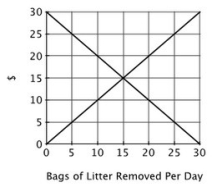 Suppose the state highway department has picked up 15 bags of litter. Protesters have staged a demonstration demanding that the highway department return to pick up the remaining litter. From an economic efficiency perspective, the protesters have a ________ claim because ________.
Suppose the state highway department has picked up 15 bags of litter. Protesters have staged a demonstration demanding that the highway department return to pick up the remaining litter. From an economic efficiency perspective, the protesters have a ________ claim because ________.
A)legitimate; litter generates a negative externality
B)faulty; the additional resources needed to remove more litter could be better used elsewhere
C)faulty; the government is not responsible for taking care of private property
D)legitimate; the government has a responsibility to take action when private market incentives do not yield the socially optimal outcome
 Suppose the state highway department has picked up 15 bags of litter. Protesters have staged a demonstration demanding that the highway department return to pick up the remaining litter. From an economic efficiency perspective, the protesters have a ________ claim because ________.
Suppose the state highway department has picked up 15 bags of litter. Protesters have staged a demonstration demanding that the highway department return to pick up the remaining litter. From an economic efficiency perspective, the protesters have a ________ claim because ________.A)legitimate; litter generates a negative externality
B)faulty; the additional resources needed to remove more litter could be better used elsewhere
C)faulty; the government is not responsible for taking care of private property
D)legitimate; the government has a responsibility to take action when private market incentives do not yield the socially optimal outcome

Unlock Deck
Unlock for access to all 184 flashcards in this deck.
Unlock Deck
k this deck
76
Suppose that the EPA has proposed strict controls on the amount of sulfur that diesel fuel contains. These controls were designed to fully offset the cost of pollution generated by diesel fuel vehicles. The effect of the regulation is estimated to increase the equilibrium price of a gallon of diesel fuel by 10 cents. Assuming that the supply of diesel fuel has a positive slope and demand has a negative slope, one can infer that the EPA determined that:
A)the external benefit of using diesel fuel is less than 10 cents.
B)the external cost of using diesel fuel is greater than 10 cents.
C)the external cost of using diesel fuel is less than 10 cents.
D)the external cost of using diesel fuel is equal to 10 cents.
A)the external benefit of using diesel fuel is less than 10 cents.
B)the external cost of using diesel fuel is greater than 10 cents.
C)the external cost of using diesel fuel is less than 10 cents.
D)the external cost of using diesel fuel is equal to 10 cents.

Unlock Deck
Unlock for access to all 184 flashcards in this deck.
Unlock Deck
k this deck
77
If an activity generates a positive externality, the government can increase total economic surplus by ________ the activity, and if an activity generates a negative externality, the government can increase total economic surplus by ________ the activity.
A)taxing; banning
B)subsidizing; banning
C)subsidizing; taxing
D)publicizing; taxing
A)taxing; banning
B)subsidizing; banning
C)subsidizing; taxing
D)publicizing; taxing

Unlock Deck
Unlock for access to all 184 flashcards in this deck.
Unlock Deck
k this deck
78
This graph shows the marginal cost and marginal benefit associated with roadside litter clean up. Assume that the marginal benefit curve and marginal cost curve each have their usual slope. 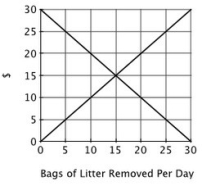 From the graph, one can infer that:
From the graph, one can infer that:
A)the marginal benefit of picking up the 10th bag of litter exceed the marginal cost.
B)the marginal cost of picking up the 10th bag of litter exceed the marginal benefit.
C)the marginal benefit of picking up the 20th bag of litter exceed the marginal cost.
D)the total benefit of having 30 bags removed is zero.
 From the graph, one can infer that:
From the graph, one can infer that:A)the marginal benefit of picking up the 10th bag of litter exceed the marginal cost.
B)the marginal cost of picking up the 10th bag of litter exceed the marginal benefit.
C)the marginal benefit of picking up the 20th bag of litter exceed the marginal cost.
D)the total benefit of having 30 bags removed is zero.

Unlock Deck
Unlock for access to all 184 flashcards in this deck.
Unlock Deck
k this deck
79
Suppose that the EPA has proposed strict controls on the amount of sulfur that diesel fuel contains. These controls were designed to fully offset the cost of pollution generated by diesel fuel vehicles. The effect of the regulation is estimated to increase the equilibrium price of a gallon of diesel fuel by 10 cents. Suppose that demand for diesel fuel is perfectly inelastic and supply has a positive slope. The effect of the regulation will ________ than if demand were not perfectly inelastic.
A)increase price and quantity by more
B)increase price by less and reduce quantity by more
C)decrease price and quantity by more
D)increase price by more and reduce quantity by less
A)increase price and quantity by more
B)increase price by less and reduce quantity by more
C)decrease price and quantity by more
D)increase price by more and reduce quantity by less

Unlock Deck
Unlock for access to all 184 flashcards in this deck.
Unlock Deck
k this deck
80
From the perspective of an externality, most communities have zoning laws to:
A)control external benefits.
B)control external costs.
C)encourage positive externalities.
D)raise government revenues.
A)control external benefits.
B)control external costs.
C)encourage positive externalities.
D)raise government revenues.

Unlock Deck
Unlock for access to all 184 flashcards in this deck.
Unlock Deck
k this deck



